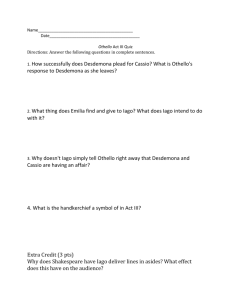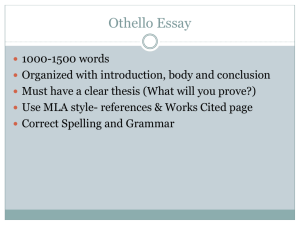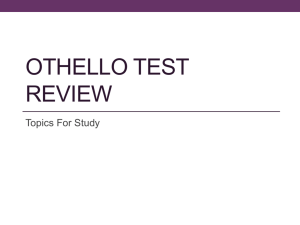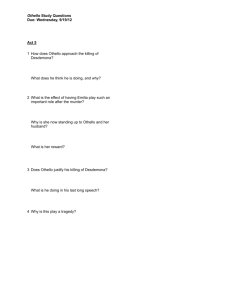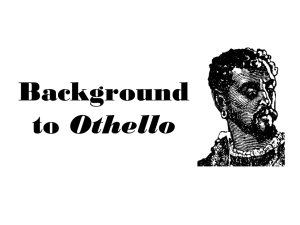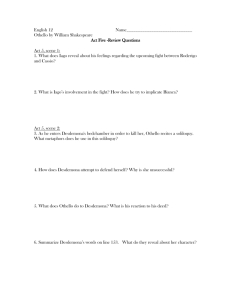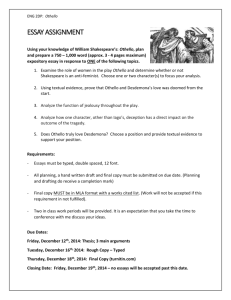Analysis guide for othello
advertisement
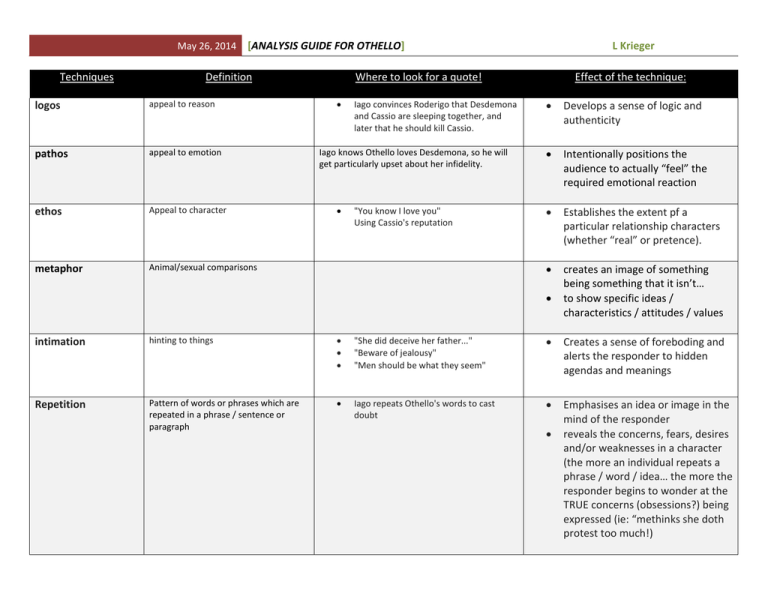
May 26, 2014 Techniques [ANALYSIS GUIDE FOR OTHELLO] Definition logos appeal to reason pathos appeal to emotion ethos Appeal to character metaphor Animal/sexual comparisons L Krieger Where to look for a quote! Iago convinces Roderigo that Desdemona and Cassio are sleeping together, and later that he should kill Cassio. Iago knows Othello loves Desdemona, so he will get particularly upset about her infidelity. "You know I love you" Using Cassio's reputation Effect of the technique: Develops a sense of logic and authenticity Intentionally positions the audience to actually “feel” the required emotional reaction Establishes the extent pf a particular relationship characters (whether “real” or pretence). creates an image of something being something that it isn’t… to show specific ideas / characteristics / attitudes / values intimation hinting to things "She did deceive her father..." "Beware of jealousy" "Men should be what they seem" Creates a sense of foreboding and alerts the responder to hidden agendas and meanings Repetition Pattern of words or phrases which are repeated in a phrase / sentence or paragraph Iago repeats Othello's words to cast doubt Emphasises an idea or image in the mind of the responder reveals the concerns, fears, desires and/or weaknesses in a character (the more an individual repeats a phrase / word / idea… the more the responder begins to wonder at the TRUE concerns (obsessions?) being expressed (ie: “methinks she doth protest too much!) May 26, 2014 Techniques [ANALYSIS GUIDE FOR OTHELLO] Definition L Krieger Where to look for a quote! Effect of the technique: Imagery Phrases / clauses create clear pictures in the reader’s imagination. Creates “feelings” and emotional responses in the responder. Animal/sexual references to Brabantio, Othello Allows the responder to visualise the ideas and values and emotions of an object, event or character. Connotation (connotative language) implied (disguised – roundabout) meaning “topped” “guilty like” Plants a seed of an idea in the minds of the character and or audience leading/rhetorical questions Did Cassio and Desdemona... "Honest, my lord?" "Indeed?" Makes a point / plants and idea / but in a way that the person being questioned feels that they actually come-up with the idea. Ellipses … allows a sentence/thought to trail off Says bad things about Desdemona, then stops and excuses himself Can plant an idea – can create ambiguity Dramatic irony … when the audience (responder” knows details about events and characters that the cast do not Soliloquies "I have a conscience" "You know I love you" "Cassio's my worthy friend" Develops a much closer connection between the characters and the audience. In very effective cases of dramatic irony – members of the audience will have to consciously “stop themselves” from yelling out the truth to the actors on stage. … a contrast between expectation and reality May 26, 2014 Techniques Understatement [ANALYSIS GUIDE FOR OTHELLO] Definition deliberately less intense statement than the true depth of meaning. L Krieger Where to look for a quote! Scattering and unsure observance "I see this hath a little dashed your spirits" "He is much changed" Effect of the technique: Can create: sarcasm irony tension Apostrophe (yes – this is also the name of a language form/feature) directly addressing an absent or imaginary person, or some abstraction "Arise, black vengeance" Develops tension. Creates various images abstract ideas and cultural values eg: spirituality, witchcraft, religion, philosophy and so on soliloquy speech to oneself Iago's speech as he plans to "turn goodness into pitch" Othello's speech as he prepares to kill Desdemona Allows the audience to “see into” the mind, thoughts, feelings, emotions and values of a character foreshadowing the use of hints and clues to suggest what will happen later in a plot The Willow Song Desdemona: "Shroud me in these sheets" Othello: "Chaos is come again" Establishes rising tension. Acts as “glue” – which connects specific ideas and themes through the text. Plants a ‘seed’ of the developing plot-line. blank verse unrhymed iambic pentameter iambic pentameter a poetic meter that is made up of 5 stressed syllables (feet) each followed Can represent brutally-honest, authentic and sometimes “evil” or amoral thoughts, actions and events. Illustrates the character (who speaks in iambic pentameter) as May 26, 2014 Techniques [ANALYSIS GUIDE FOR OTHELLO] Definition (verse) by an unstressed syllable simile a comparison using like or as personification the act of attributing human characteristics to abstract ideas etc. Oxymoron Two opposite words – right next to each other. Two opposite phrases – right next to each other can also be identified as oxymoron. Juxtaposition / contrast Two opposite ideas which are express in the same sentence / paragraph / dialogue L Krieger Where to look for a quote! Effect of the technique: being cultured, refined, poetic, persuasive – and so on. The thought of Emilia and Othello together gnaws like a poisonous mineral at Iago's innards Jealousy as green-eyed monster Creates confusion. Develops “duplicity” in a character’s personality and/or motives. Emphasises one idea or belief by contrasting it with the opposite idea. (eg: Luke Skywalker is good – Darth Vader is bad. Darth Vader appears even more evil in “contrast” to Luke). Can also create confusion. Paradox A contradiction – a statement in which one idea “cancels out” itself. Emotive language tone The deliberate use of positive or negative language (words) Creates a visual image of a specific personality trait of a character – or thing. Creates a visual image of an idea as being positive or negative… Creates confusion and contradiction. Represents the mood and opinions of the speaker / the composer. May 26, 2014 Techniques [ANALYSIS GUIDE FOR OTHELLO] Definition Allusion A reference to a person, a religious idea, a famous text (painting, film, poem, book, myth) Alliteration Repetition of a consonant letter at the beginning of (at least) 2 words in a single phrase Assonance Repetition of a vowel letter at the beginning of (at least) 2 words in a single phrase – or the repetition of vowel sounds in a phrase / sentence L Krieger Where to look for a quote! Religious references by Othello References to Greek mythology Effect of the technique: Reveals the cultural and religious and social values, attitudes and “interests” of a character. Creates sound imagery Develops rhythm which positions the responder to feel ‘comfortable’ with the meaning of the words Creates soft sounds and develops images of a setting (eg: wind) Develops a ‘softness’ in a character’s personality – shows a calm and quiet dignity May 26, 2014 [ANALYSIS GUIDE FOR OTHELLO] L Krieger
